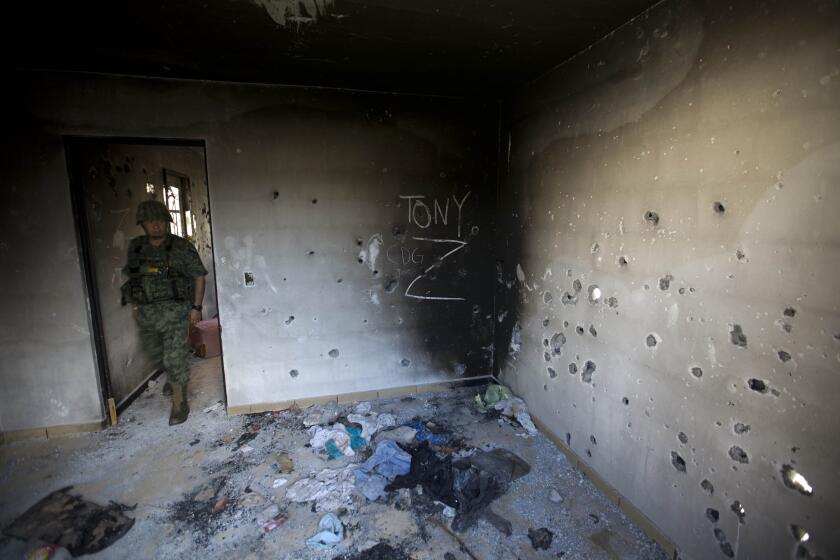Eastern Reform Could Cut B-2, Cheney Says
WASHINGTON — Defense Secretary Dick Cheney said Tuesday he might reconsider some of his 1991 budget proposals for major new weapons systems, including the B-2 Stealth bomber, if developments in the East Bloc justify changes. He called on lawmakers to be “flexible just like we are.”
Signaling flexibility only one day after submitting a $295.1-billion defense budget, Cheney said he could not rule out the possibility of scaling back the program for B-2 bombers, which are built in Southern California. Cheney has asked for $5.5 billion for 1991 for the program. He gave conflicting signals as to whether he could be flexible about spending for the Strategic Defense Initiative, or “Star Wars,” now slated to cost $4.5 billion in 1991.
However, Cheney said there are no Soviet developments “in the realm of possibility” that would justify an easing of the Bush Administration’s over-all strategic modernization plan.
Although he did not spell out which modernization systems were off limits to compromise, strategic modernization includes submarines that carry Trident missiles, a new rail-based scheme for the MX missile, and Midgetman, a small single-warhead missile.
“Unless you’re talking about significant Soviet unilateral reductions in their strategic forces, and I would argue there’s no evidence at all” of such reductions, “I would argue that we need to continue to modernize our own strategic forces to protect and preserve the deterrent,” Cheney said at a meeting with a small group of reporters.
“Star Wars” and the Stealth bomber are strategic modernization systems. However, in answering a direct question, Cheney said he could not rule out cuts in the Stealth bomber. He did defend the bomber generally as a key factor in current arms control negotiations.
At one point he staunchly defended “Star Wars” as essential, but at another point he listed “Star Wars” as among the systems that are being studied by the Pentagon. He said changes in the budget as a result of Pentagon reviews are “entirely possible.”
Other areas under review include a trio of other costly aircraft programs--the C-17 transport, the Navy’s A-12 aircraft and the Air Force’s advanced tactical aircraft.
C-17 Also Built in Area
Like the B-2, the C-17 is being built in the Los Angeles area. Several Southern California defense contractors have major interests in the Navy and Air Force tactical aircraft programs, still in development.
The Air Force has estimated that its planned purchase of 132 B-2 bombers will bring the program’s total cost to $68 billion.
Cheney said that, although the NATO alliance is counting on the United States to develop two new short-range nuclear missiles, an alliance-wide shift might cause him to withdraw or reduce requests for a total of $269 million to develop the successor to the Lance missile and a nuclear-tipped missile delivered by aircraft.
“At some point, you have to send the budget to the printer,” Cheney said. “But the process doesn’t quit.”
Cheney is under great pressure by Congress to cut the defense budget because of an enormous deficit and because developments in the East Bloc have raised expectations of a “peace dividend” that would free money for domestic programs.
Referring to changes in Eastern Europe, Cheney said: “We need, to the extent we can, to reflect those changes in our budget in order to have a credible package on Capitol Hill.” The defense secretary’s show of flexibility comes as lawmakers vowed to remake Cheney’s budget blueprint, which would increase spending to develop missile defenses and build new nuclear weapons while cutting troops and closing bases.
Cheney seemed hopeful that his own willingness to compromise would allow him to maintain his grip over his 1991 budget request, which met with widespread congressional criticism.
Stakes in Contest
What is at stake in the tug of war over the defense budget is not only the Bush Administration’s imprint upon the armed forces’ future, but also Cheney’s reputation as an effective political broker schooled in the art of compromise.
At the same time, Cheney drew the line against defense cuts deeper than the 22% reductions he has plotted for the next five years. He seemed to suggest that, although he is willing to make concessions this year and on specific systems, he hopes to play the major role in shaping long-term policy decisions.
Although the “Star Wars” missile defense program is one of several major projects under review, Cheney defended the program, for which he is seeking $4.5 billion next year--a $900-million increase. The threat of Soviet strategic missiles hasn’t changed, he said.
Cheney, a former Wyoming congressman whose political savvy won him the job as defense chief, has emerged as one of the Bush Administration’s leading skeptics on the prospects for Soviet reform. Citing the dearth of change in the Soviet long-range nuclear arsenal, Cheney made clear that, although he will make some concessions to lawmakers, he will not threaten strategic modernization before there is stronger evidence of Soviet change.
“I have to spend my time dealing with the world as I find it, and the world as I find it is a robust modernization program now under way in the Soviet Union,” Cheney said. He said Congress must “distinguish between the atmospherics of the moment, the mood of the Soviet leadership on the one hand, and on the other hand, Soviet military capabilities, which are formidable in the strategic area and have improved during Mr. Gorbachev’s reign.”
Cheney remembered wistfully his days as a lawmaker, when the defense budget was a weeklong preoccupation once a year. From that experience, he said, he has concluded that, in the end, Congress will do little more than tinker at the margins of his budget, fighting over “two or three items that will be especially controversial.”
“Congress always zeroes in on a few issues and those are the ones we fight about,” Cheney said. “In reality, if you go back and look over the last several years--most of the time, most of the budgets submitted by the President--most get approved by the Congress. I think that will happen again, although we’re clearly going to have significant controversy.”
FUROR OVER BASES--Democrats seek to revive bipartisan panel to decide which military facilities to close. A12
More to Read
Sign up for Essential California
The most important California stories and recommendations in your inbox every morning.
You may occasionally receive promotional content from the Los Angeles Times.











